For much of the seventeenth through mid-nineteenth centuries, Japan’s Tokugawa leaders sealed off their country from the world, turning political, social, and economic planning and policy inward. It was not necessarily illegal to leave Japan, yet should you return, you would get your head chopped off (castaways could be exempted, although not always). Foreign arrivals were heavily regulated, being almost exclusively restricted to diplomats from the Choson, Qing, and Ryukyuan courts to convey tribute and news.
Thus mediated, firsthand awareness of the formative moments of great modern Western industrial transformation and empire building—particularly by Britain and France—remained largely unknown to Tokugawa officials. That said, a famous chink existed in this wall on the man-made island of Dejima off the southern city of Nagasaki, where a small Dutch population lived (only Dutch and Chinese ships were allowed into port). The shogun had banished most Europeans (threatened by the rapid spread of Portuguese efforts at Catholic conversion), yet he permitted a handful of Dutch employees of the Dutch East India Company to remain at this heavily controlled outpost. They mainly imported cotton and silk from India and China and bought silver, copper, porcelain, and lacquerware for export.
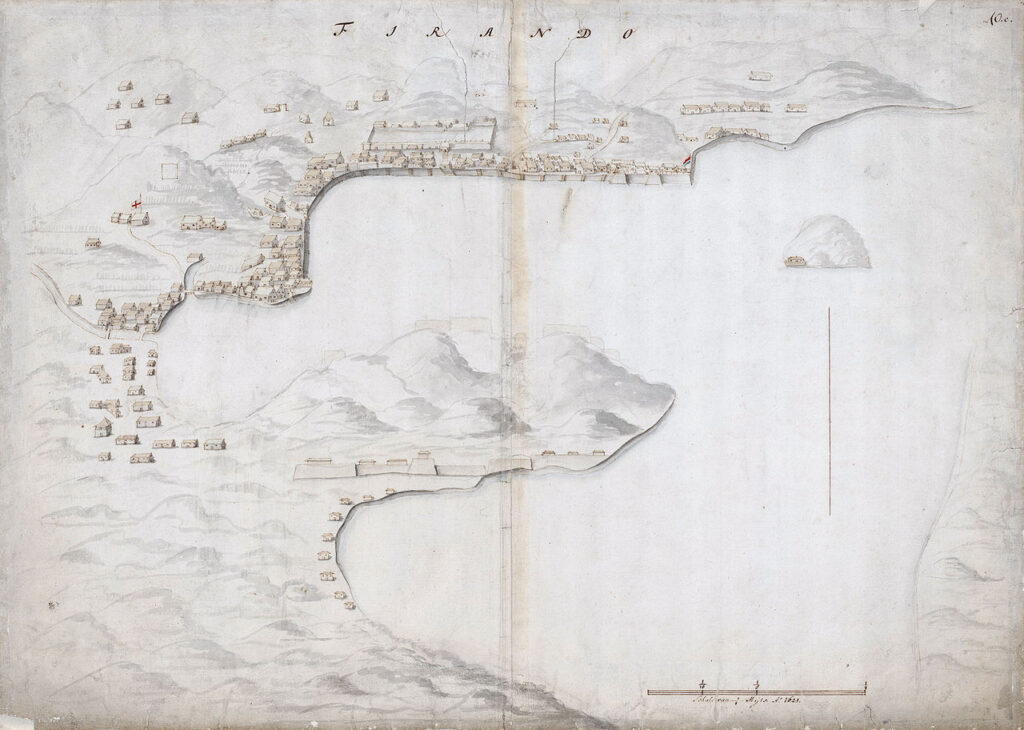
Importantly, the Dutch traders also brought books to Dejima with them. Over time the body of knowledge from these texts that grew among a small group of Japanese scholars became what historians call “Dutch studies.” It was through the translation and authoring of texts such as Nishikawa Joken’s 1708 Account of Foreign Countries (Zoho Kaitsu Shoko) and Morishima Churyo’s 1787 Sayings of the Dutch (Komo Zatsuwa) and their accompanying maps and diagrams that these scholars and their students would inform Japan’s leaders about world conditions of the era. In short, the mental map for Japan’s future empire building and territorial imaginings began to take shape through this means of knowledge gathering.
Japan’s Imperial Expansion
Around 1800, the Tokugawa government exhibited a new form of curiosity and began to order its officials to create new kinds of maps—for Japan at least—that would make clear to foreigners who had already drawn Japan onto their maps that the realm was not up for grabs. The government wanted maps that could express Japanese rule over Japan in ways that made sense to foreigners who were not Chinese or Korean.1
Thus, from these early moments in the nineteenth century, it is possible to consider modern Japanese nation building and later empire building as defensive. This is especially interesting because delineating the official reach of Tokugawa lands caused great anxiety among Japan’s rulers at a time when they were not even imagining that they would lose control of their own country in less than a century.2
In particular, Russia had begun to challenge the Tokugawa claim that Ezo (known today as Hokkaido) was Japanese territory, and the Tokugawa government wanted to assert its control. For example, in the early 1800s a Russian ship returned several Japanese castaways to Japan, together with a Russian world map in which Ezo was not drawn as part of Japan. Japanese officials wanted to make sure of two things: first that Russia not begin to people this territory—Japanese had established trade with the native Ainu by this point; and second that Japanese control over Ezo was represented on a detailed longitudinal and latitudinal map similar to the one that Russia had sent. In 1809 the government commissioned Ino Tadataka to make such a map. He made multiple versions, denoting not only Ezo as Japanese territory but also islands farther to the north (including those contested today with Russia). Notably, Ezo would become the young Meiji government’s first colony for imperial expansion. The Meiji government renamed it Hokkaido (literally, Route to the Northern Sea) when they took control in 1869.
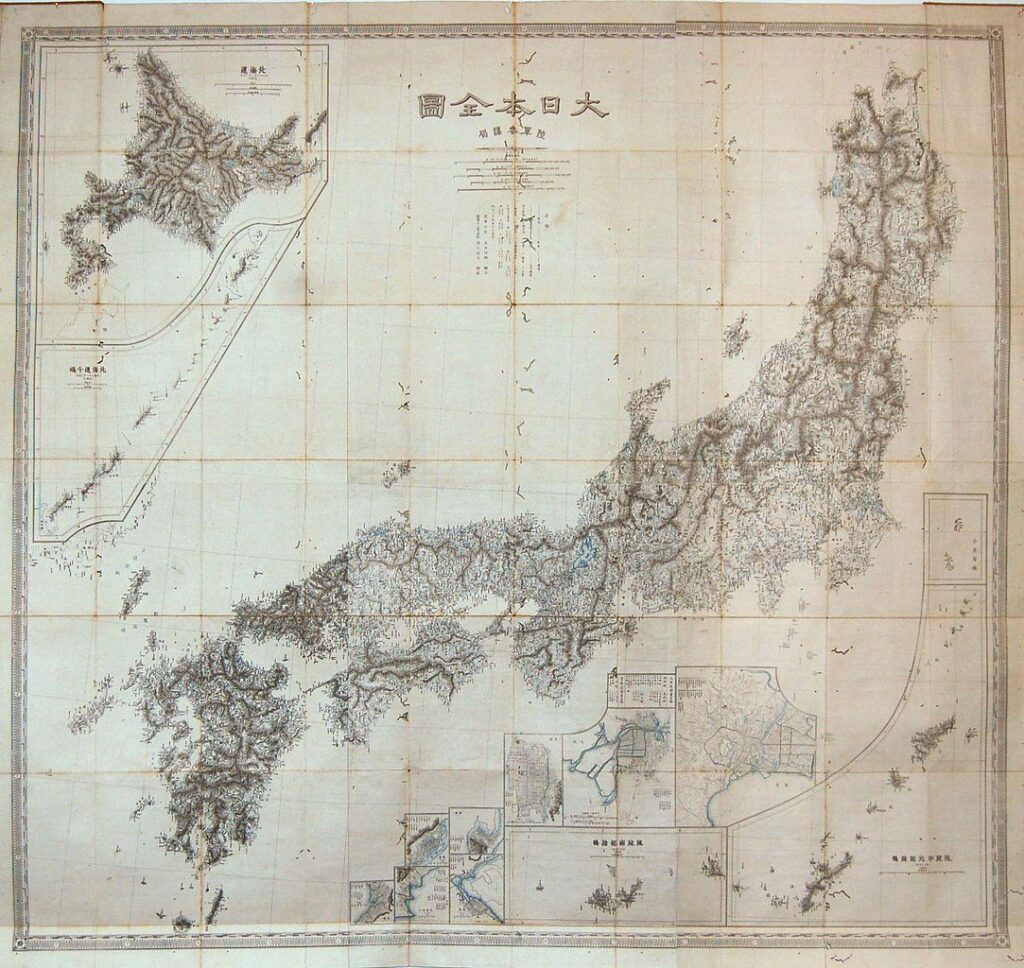
When young samurai revolutionaries overthrew the Tokugawa regime and replanted the emperor at the seat of power, ushering in the Meiji era in 1868, the new government’s most important strategic thinkers, Mutsu Munemitsu and Yamagata Aritomo, continued to think defensively about expansion. The colonization of Hokkaido, however, required an entirely new way of agriculture and a pioneering technique modeled heavily on the American experience first in New England and then as part of the United States’ espousal of Manifest Destiny.3 The United States’ frontier army, for example, provided the guide for Japan’s frontier militia in Hokkaido, which was discrete from the imperial army and created for the suppression of the indigenous peoples of Hokkaido.
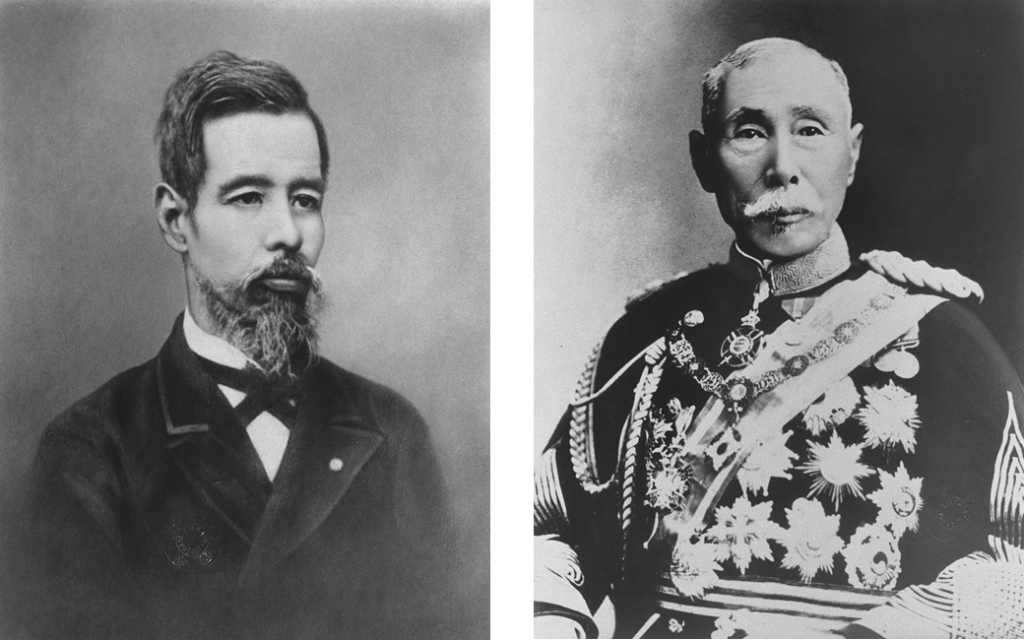
Japan’s overthrow of the Ryukyu king in 1879 and annexation of his territory (collectively today called Okinawa) was part and parcel of the era’s evolving “southern advance” strategy. Theorists have digressed over time into arguments that the nascent empire’s “southern” push was economic while the “northern” feature was more security oriented (and perhaps “northwest” too).4 Ultimately, however, it is more helpful to understand that this dichotomy between economic and security goals arose more academically during the post-1945 era. This historiographic debate revolved around Japan’s expansionism as different from European models—let alone the United States. Yet for all intents and purpose the 1879 annexation of the Ryukyu Islands was very much in keeping with these other histories (including employment of foreign legal and military advisers to ensure that Japan was following the “rules of the game”) as well as with the country’s broader defensive approach to empire building. The ramifications of this moment continue to be felt to this day with Okinawan territory treated as a fortified buffer zone to protect Japan’s main islands.
Notably, just prior to Tokyo’s 1879 annexation of the Ryukyu Kingdom, young Meiji officials raced back from their famous around-the-world study tour—the Iwakura Mission from 1871 to 1873—to prevent disgruntled former samurai under the lead of Saigo Takamori from attempting to invade and conquer Korea. It was not that Korea was outside Meiji government strategic thinking; rather, on their world tour, Japan’s policymakers had seen for themselves the industrial bases of the world’s capitals in Europe and the United States that undergirded territorial expansion and conquest. Modern Japan’s first incursion against Korea followed shortly after in 1875 to test Korean defensive capability, and by 1910 the entire country was brought under Japanese control. With Japan’s expansion to the southwest through the annexation of Taiwan in 1895, the East China Sea itself was poised to become a new kind of “inland sea.” Notably, the Japanese name for this body of water today still uses the imperial-era term “Shina” for “China.”
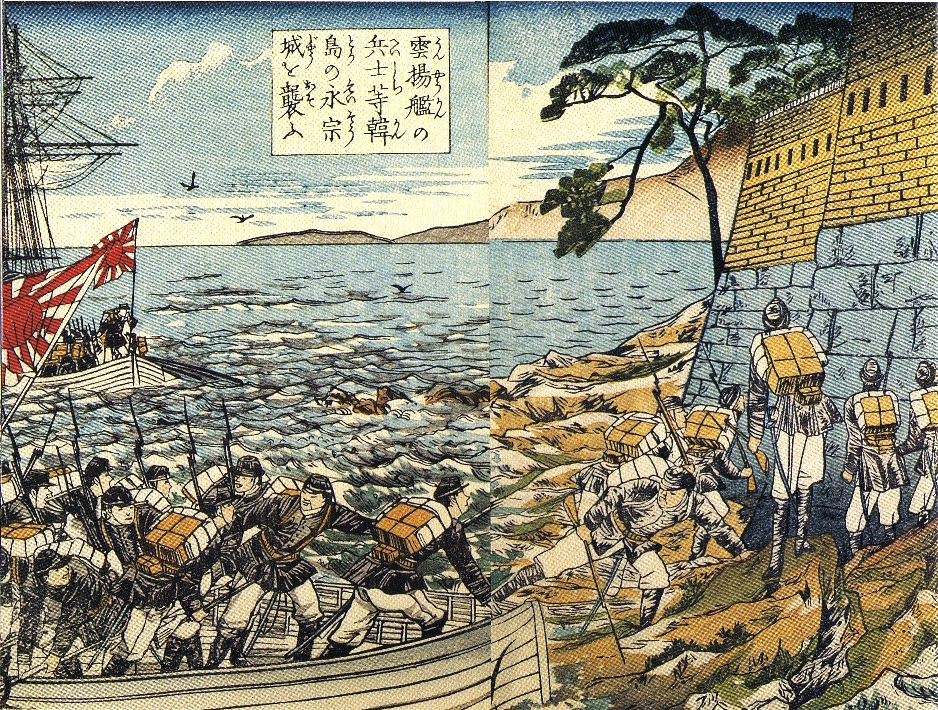
The Disappearance of Imperial Japan
The Empire of Great Japan (Dai Nippon Teikoku) met with cataclysmic defeat in 1945, a year Japanese officials renumbered 2605 on their mental maps. This chronological counter to the by then global Gregorian standard was called the Koki system and based on the putative birth year of the legendary Emperor Jimmu in 660 BCE. Technically, this temporal measurement went into effect in 1872. Not until 1932, however, and the full-blown establishment of Japan’s puppet state of Manchukuo did it garner much attention or traction. At that point, the northern Chinese city of Changchun was in the process of being renamed New Capital (Shinkyo), with plans underway for radiating Japanese-led “East Asian greatness” from that spot in northern China. At this juncture, too, it becomes clear that ideological forces were racing ahead of earlier, more cautious expansionary steps—and with ever increasing rage—as the Greater East Asia Co-Prosperity Sphere took hold of Japan’s strategic thinking.
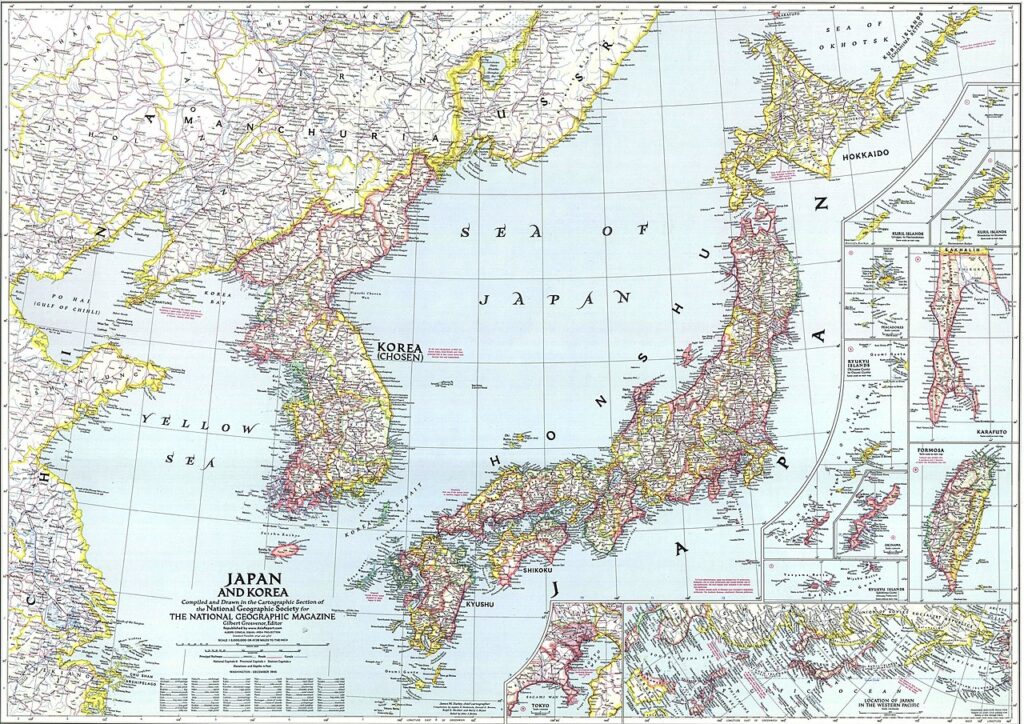
One of the greatest difficulties with resurrecting this moment of Japanese imperial expansionism for comparative purposes stems from the violence and speed of its disappearance. For years, many Japanese used the term “phantom” (maboroshi) to describe this lived history and its vanishing (the few living survivors may still use the word). This raises the question of how such a sprawling phantom was conceived. After all, Manchukuo among other places in Japan’s enormous empire was a real place—a homeland—to an estimated fifty million inhabitants (a population that included at least one million Japanese colonists and a similar number of ethnic Korean subjects of the empire). Put differently and in spatial terms, looking at the creation of Manchukuo as akin to the 1803 Louisiana Purchase for U.S. expansion and history, what impelled Japan’s imperial strategists to continue to conceive their mental map of empire to the point of its complete unsustainability and utter destruction?
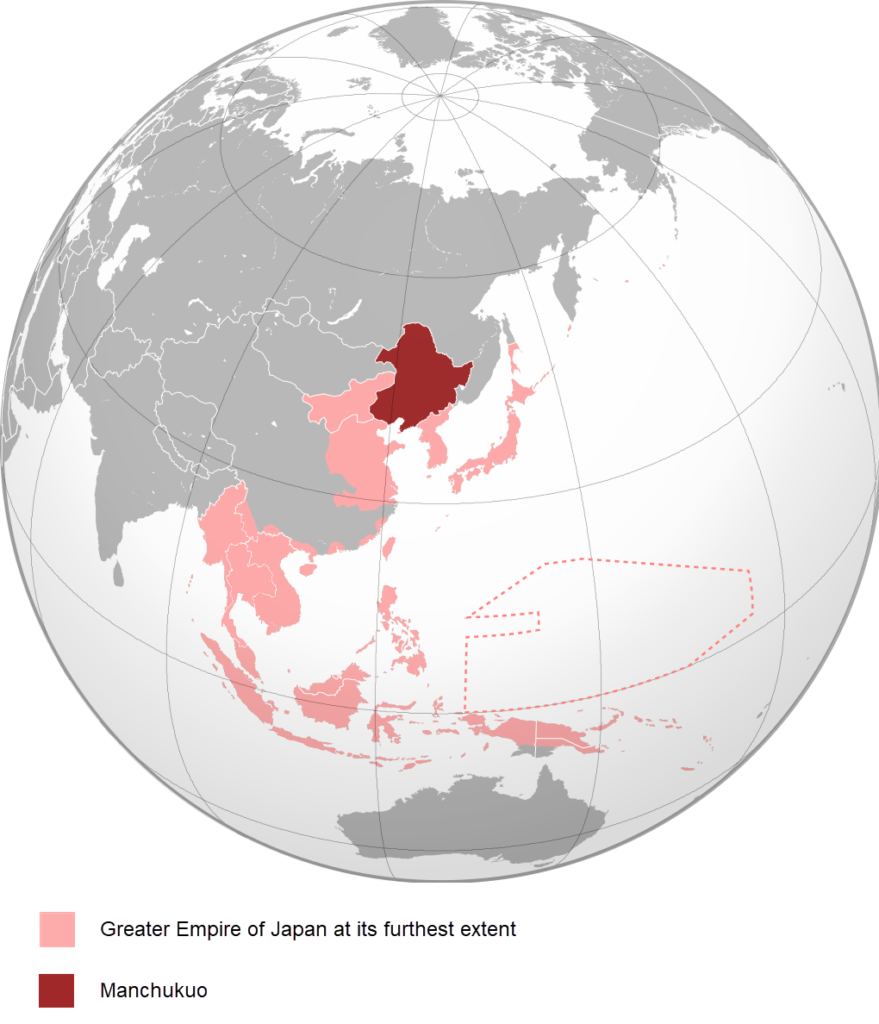
Three factors stand out as helpful for considering Japan’s strategic space today: first, the importance of understanding Japan’s initial nation-building effort as a “defensive empire”; second, the significance that Japanese leaders placed on engaging with global trends and norms of the times; and third, ideological doctrines of Japanese superiority vis-à-vis other Asian races, which overruled more cautiously planned maps to the point of overextension. By the 1930s, so sure were Tokyo’s imperial strategists of the span of their hoped-for conquests that official publications described northern China for all intents and purposes as a neolithic and lawless land that begged for Japan’s guiding hand. They promised that Tokyo’s clarion wisdom would reinvigorate an ancient Asia in modern terms, all of which would be situated in the New Capital. Multicolored flags flew to denote the various races involved in this new future, even as hierarchical assimilation policies were the name of the game: Japanese language prevailed in government, business, and education.
By the time imperial Japan’s strategists opened war in Southeast Asia and the Pacific against British, French, Dutch, and Americans in their imperial holdings, the grounds were already laid for battles to be understood as race wars above all. As historian John Dower famously elaborated in his book of the same name, “war without mercy” rested on the wholescale dehumanization of the “other” on all sides. Attempts at territorial conquest went hand in hand with attempts at total annihilation of soldier and civilian alike.
Alexis Dudden is Professor of History at the University of Connecticut.
IMAGE CREDITS
Banner illustration by Nate Christenson ©The National Bureau of Asian Research.
Bay of Hirado in 1621. | Wikipedia: Public Domain
Meiji 11 or 1878 pocket or folding map of Japan. | Wikipedia: Public Domain
Japanese marines from the gunboat Un’yō landing on Yeongjong Island on September 20, 1875. | Wikipedia: Public Domain
Map of Japan and Korea (1945), National Geographic. | Wikipedia: Public Domain
Mutsu Munemitsu (1844‒97). | Wikipedia: Public Domain
Yamagata Aritomo (1838‒1922). | Wikipedia: Public Domain
Greater Empire of Japan at its furthest extent. | Wikipedia: Public Domain
ENDNOTES
- For comprehensive discussion of the transformation of maps and mapmaking in Japanese history, see Kären Wigen, Sugimoto Fumiko, and Cary Karacas, eds., Cartographic Japan: A History in Maps (Chicago: University of Chicago Press, 2016)
- Bob Tadashi Wakabayashi’s treatment of early- to mid-nineteenth-century Japanese strategic thinking remains paramount. See Bob Tadashi Wakabayashi, Anti-Foreignism and Western Learning in Early-Modern Japan: The New Theses of 1825 (Cambridge: Harvard University Press, 1986).
- See my chapter “Nitobe Inazo and the Diffusion of a Knowledgeable Empire,” in Empire and the Social Sciences: Global Histories of Knowledge, ed. Jeremy Adelman (London: Bloomsbury Academic, 2019), 111–22.
- Setting the terms for this ongoing historiographical debate in English was Ramon H. Myers and Mark R. Peattie, ed., The Japanese Colonial Empire, 1895–1945 (Princeton: Princeton University Press, 1984). See also, Mark Driscoll, Absolute Erotic, Absolute Grotesque: The Living, Dead, and Undead in Japan’s Imperialism, 1895–1945 (Durham: Duke University Press, 2010); and Seiji Shirane, Imperial Gateway: Colonial Taiwan and Japan’s Expansion in South China and Southeast Asia, 1895–1945 (Ithaca: Cornell University Press, 2022).

